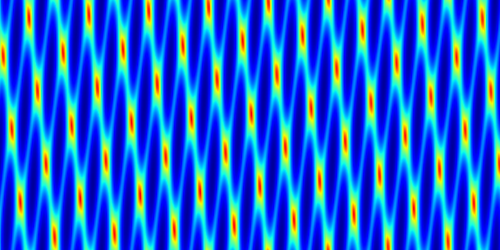Carving a Space-Time Crystal in a Plasma
Plasmas of charged particles—electrons or ions—can act as mirrors that reflect high-intensity light without being damaged. This property has been exploited to build plasma mirrors and other optical components for high-power lasers such as those used at the National Ignition Facility. Now, Vadim Munirov at the University of California, Berkeley, and colleagues have theorized a new plasma-based grating concept [1]. In their design, lasers produce a plasma-density modulation that is quasiperiodic in both space and time—a space-time “quasicrystal.” This traveling grating could be used to diffract laser pulses or to accelerate charged particles that “surf” on the grating.
In the proposed scheme, overlapping laser beams excite the plasma and produce an oscillation of the ions known as an ion acoustic wave. This wave, which can be described as a nonlinear function of two phase parameters, modulates the plasma density in both space and time. Solving the nonlinear equations that describe the laser-driven plasma, the team showed that these density-wave modulations can be substantial—with plasma density peaks twice as large as the average plasma density. Such large modulations arise from “autoresonance,” a mechanism by which the phases of the nonlinear wave automatically adjust so that the driving lasers can continuously transfer energy to the wave.
The proposed scheme would have some advantages over previous ones, says Munirov. For instance, the autoresonance boost would allow the grating to be produced with lower-intensity laser pulses. What’s more, the grating would persist even after the driving lasers are turned off. In previous schemes, the grating disappears almost immediately, meaning that complex timing techniques are required to sync the grating with the laser pulses it is meant to diffract.
–Matteo Rini
Matteo Rini is the Editor of Physics Magazine.
References
- V. R. Munirov et al., “Autoresonant excitation of space-time quasicrystals in plasma,” Phys. Rev. Research 4, 023150 (2022).




